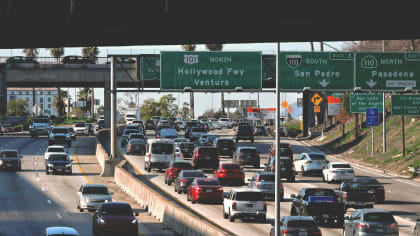TOYOTA AIMS FOR 10 IN A ROW
This article is from our archives and has not been updated and integrated with our "new" site yet... Even so, it's still awesome - so keep reading!
Published on Wed, Aug 24, 2011
By: The LACar Editorial Staff

HOT WIRE—If you make the best-selling car for the past nine years, chances are, you aren’t going to mess with a winning formula. That must be what Toyota had in mind when it set out to create an all-new version of its Camry line. For 2012, the all-new Camry doesn’t look all that different from the out-going 2011 model—never mind that the two share not a single body panel. The reality: The quintessential Camry owner cares not too much what the car looks like. And so Toyota decided to focus on what matters to Camry owners—i.e., getting the most for your money, miles per gallon, and the bottom line. On these three factors, the new Camry has more standard features, gets better gas mileage, and is cheaper than the out-going model—a pretty amazing feat in this day and age.
As it introduced the new Camry at Paramount Studios in Hollywood, California, the folks at Toyota also claim the new car has a more spacious interior while generally keeping the same overall exterior dimensions, improved driving dynamics, and an even quieter ride than before. If the new car continues the company tradition of reliability and dependability, we have no doubt that the Camry will continue its best-seller status.

“The all-new 2012 Camry blends an evolution of the car’s values – such as comfort, efficiency, reliability and safety – with a more appealing design and engaging driving experience,” said Bob Carter, Toyota Division group vice president and general manager. “Competition in the midsize sedan segment is the strongest it’s ever been, and the all-new Camry is designed to maintain its long-standing leadership while also broadening its appeal.”
All Camry models with the revised 2.5-liter four-cylinder engine now offer 178 horsepower, an increase of nine hp, and 170 lb.-ft. of peak torque. EPA-estimated fuel economy figures are 25 mpg city/35 highway, and the 28 mpg combined is two more than the previous generation Camry. The 2.5-liter engine employs Dual VVT-i (Dual Variable Valve Timing-intelligent), which controls valve timing on both the intake and exhaust camshafts for optimal performance and efficiency at all engine speeds. The Acoustic Control Induction System (ACIS) helps optimize torque over a broad engine speed range, according to Toyota.

The DOHC 3.5-liter V6, available in the SE and XLE grades, delivers 268 horsepower at 6,200 rpm and 248 lb.-ft. of peak torque at 4,700 rpm. Enhancements to this engine boost its fuel economy to projected EPA-estimated ratings of 21 mpg city/30 mpg highway, the best for any current V6 midsize sedan according to Toyota. The V6 uses chain-driven camshafts and Dual Variable Valve Timing with intelligence (Dual VVT-i).
The gas-engine LE, XLE and SE models come equipped exclusively with a six-speed automatic transmission that offers a sequential manual shift mode using the console shifter. Intelligent control adapts shifting strategy in response to driver input, with fast kick-down. In addition, the Camry SE exclusively offers a “D range” sequential shifting, which allows manual shifting with the new steering wheel paddle shifters even when the console shifter is in the “D” mode. Also exclusive to the Camry SE, the automatic transmission features faster shift times when in “S” mode and downshift blipping control emphasizes a sense of sportiness.
The New Hybrid
The new Camry Hybrid debuts a highly revised version of the brand’s Hybrid Synergy Drive powertrain, including a new 2.5-liter four-cylinder engine. “The 2012 Camry Hybrid LE, with EPA-estimated 43 mpg city/39 mpg highway/41 mpg combined, yields a more-than-30 percent boost in fuel economy in the EPA city and combined driving cycles, compared to the previous generation, thanks largely to the new hybrid powertrain, but also due to lighter vehicle weight and optimized aerodynamics,” says Carter.
“Lighter overall vehicle weight also contributes to better performance and fuel economy.” Its 7.6-second zero-to-60 acceleration time places the Camry Hybrid between the four-cylinder and V6 models. “Lower rolling resistance tires, available for the first time in 17-inch size, also help boost fuel economy.”

Inside
While featuring nearly the same external dimensions as the previous generation, the 2012 Camry offers a more spacious interior. “A new dashboard design, modified seat locations, redesigned seats and ‘lean’ door, pillar and headliner trim all combine to add both real space and greater perceptual spaciousness while also enhancing outward visibility,” says Carter. “Repositioning the driver’s seat and the standard tilt/telescoping steering wheel (tilt has increased 33 percent for greater driver comfort) also aid forward visibility and enhance the driver’s positioning.”
The accelerator pedal and front seats were moved forward, and the rear-seat hip point was positioned rearward, increasing the couple distance by 0.6-inch; together with reshaped front seatbacks help increase rear-knee room by 1.8-inch. The redesigned center console and front edge of the rear-seat cushion increase rear middle seat legroom by two inches.
Soft textures used on the upper instrument panel, upper door trim, door armrests and center console armrest contribute to greater comfort in the Camry. Stitching on the instrument panel soft padding (a first for a car in this class) and matching stitching-look trim elsewhere helps to create a sense of luxury.

A Quieter Camry To reduce noise throughout the entire cabin, Toyota says it focused on suppressing noises that stand out. “As powertrains have become more refined and quieter, wind noise and road noise have tended to become more noticeable to drivers and passengers. A low noise reading (in decibels) does not always equate to a subjectively quiet interior,” says Carter. “Vehicle occupants’ perception of quietness also depends on the type and frequency of the sound. In particular, engineers focused on suppressing noises that are near the frequencies of human speech to provide an environment that is more comfortable for conversation.” For more information on the 2012 Camry, click here




